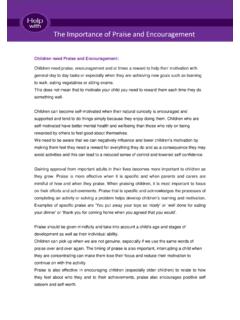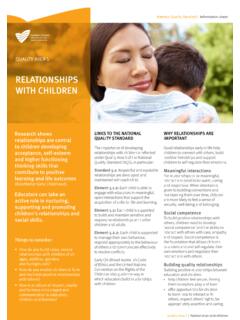Transcription of Dysfunctional Family Structures and Aggression in Children ...
1 1 Dysfunctional Family Structures and Aggression in Children : A Case for School-Based, Systemic Approaches With Violent Students Charles R. McAdams III and Victoria A. Foster The College of William & Mary Kylie Dotson-Blake East Carolina University Johnston M. Brendel The College of William & Mary Dysfunctional Family 2 Abstract School counselors may be in the best position to identify troubled students and intervene before an act of school violence occurs. Current education literature challenges school counselors to expand their knowledge of social, environmental and Family dynamics and the influences of those dynamics on student violence.
2 This article will (a) introduce the structural elements of a Family system (b) describe links between Dysfunctional Family structure and child Aggression , (c) propose school-based strategies for working with students and their families that address the structural antecedents of Aggression , and (d) underscore the feasibility and benefits of a systemic approach to violent students. Dysfunctional Family 3 Dysfunctional Family Structures and Aggression in Children : A Case for School-Based, Systemic Approaches With Violent Students Communities and schools are currently facing unprecedented levels of unmet mental health needs, and Children with emotional or behavioral challenges are less likely to learn while at school (Nabors, Leff, & Power, 2004).
3 In 2005-6, 86 percent of US public schools reported that one or more serious violent incidences occurred at their school ( Department of Education, 2002). Schools and mental health centers report an increase in Children who display externalizing behavior problems, which refers to a range of rule breaking behaviors and conduct problems, including physical and verbal Aggression , defiance, lying, stealing, truancy, delinquency, physical cruelty and criminal acts. Any instance of crime or violence at school not only affects the individuals involved but also may disrupt the educational process and affect bystanders, the school itself, the families of students and the surrounding community (Henry, 2000).
4 The majority of counselors who will first come into contact with issues of school violence are school counselors; as a result, school counselors may be in the best position to assess troubled students in an effort to identify and intervene before an act of violence occurs (Daniels, 2002). Current literature in education challenges school counselors to expand their knowledge of social, environmental and Family dynamics and the corresponding influences of those dynamics on violent student behavior (Bryan, 2005; Epstein, 2001). This is because the roots of most violent behavior appear to develop during childhood, the time when Family members and Family processes are characteristically the most prevalent influences in an individual's life (Paylo, 2005).
5 Youth who commit most of the violent acts, who commit the most serious violent acts, Dysfunctional Family 4 and who continue their violent acts beyond adolescence began their behaviors during childhood ( Department of Health and Human Services, Substance Abuse Mental Health Services Administration [SAMHSA], 2001). The apparent influence of Family dynamics on violent behavior in youth may help explain why efforts to describe, predict, and address youth violence on the basis of personality or character traits alone have proven extremely difficult (Quinsey, Harris, Rice, & Cormier, 2006).
6 When a student is threatening or exhibiting aggressive behavior in school, school counselors are encouraged to avoid interventions that focus solely on the child and minimize or ignore the larger contexts within which he or she is developing (Edwards & Foster, 1995). As noted above, the Family is a central factor in the development and reduction of antisocial behaviors and delinquency. Consequently, school-based interventions to strengthen positive Family involvement seem best suited to address the current trends in youth Aggression and unmet mental health needs (Epstein, 2001).
7 To apply Family -inclusive prevention and intervention approaches to student violence, school counselors must first understand the antecedents of student violence that originate in the context and structure of the Family . Toward promoting such understanding, this article will (a) address the social context of student violence, (b) review the structural elements of a Family system, (c) describe the link between a Dysfunctional Family structure and Aggression in youth, (d) propose school-based strategies for working with both aggressive students and their families, and (e) underscore the feasibility and benefits of a systemic approach to violent students.
8 Dysfunctional Family 5 Social Context Social isolation, socioeconomic disadvantage and deprived neighborhoods are adverse factors that have been related to Aggression in Children (McAdams, 2002). Poverty in particular appears to cut across racial and cultural boundaries in ways that contribute to conduct disorder and interfere with intervention efforts (Prinz & Miller, 1996). Environmental stressors limit Family access to adequate and safe housing, employment, education, healthcare, and transportation. Parents in low-income families must often work longer hours to compensate for low wages.
9 Understandably, they may be less present for their spousal, parenting, and Family leadership roles. Financial challenges may lead to inadequate childcare for Children of low-income families. If forced to fend for themselves for long periods without parental protection and support, Children from low-income families may, out of necessity, develop aggressive skills in order to manage and survive their potentially dangerous environment. Limited Family resources may encourage low-income Children to rely upon peer groups for social support and self esteem ; such peer groups can cultivate patterns of aggressive behavior that are unacceptable in other contexts.
10 Distinguishing between cultural-bound aggressive behavior and other types of Aggression is crucial for accurate assessment and effective intervention. The ability to recognize differences and similarities among families across class, race, and cultural cir cumstances challenges the prevailing view of diversity as pathological or dangerous, and prevents misinterpretation of behavior and characteristics that hold relevance in a particular context. School counselors hold a unique perspective on both the larger Dysfunctional Family 6 community and the Family systems within that community that can engender effective intervention.

















